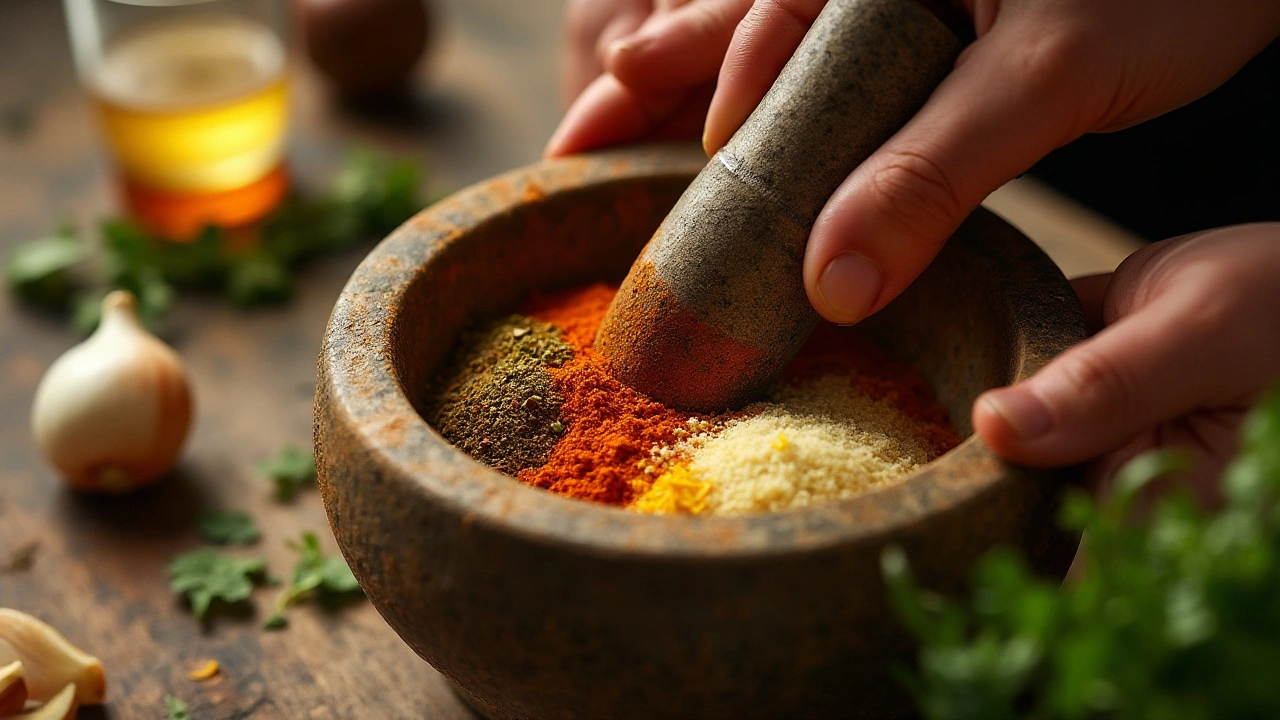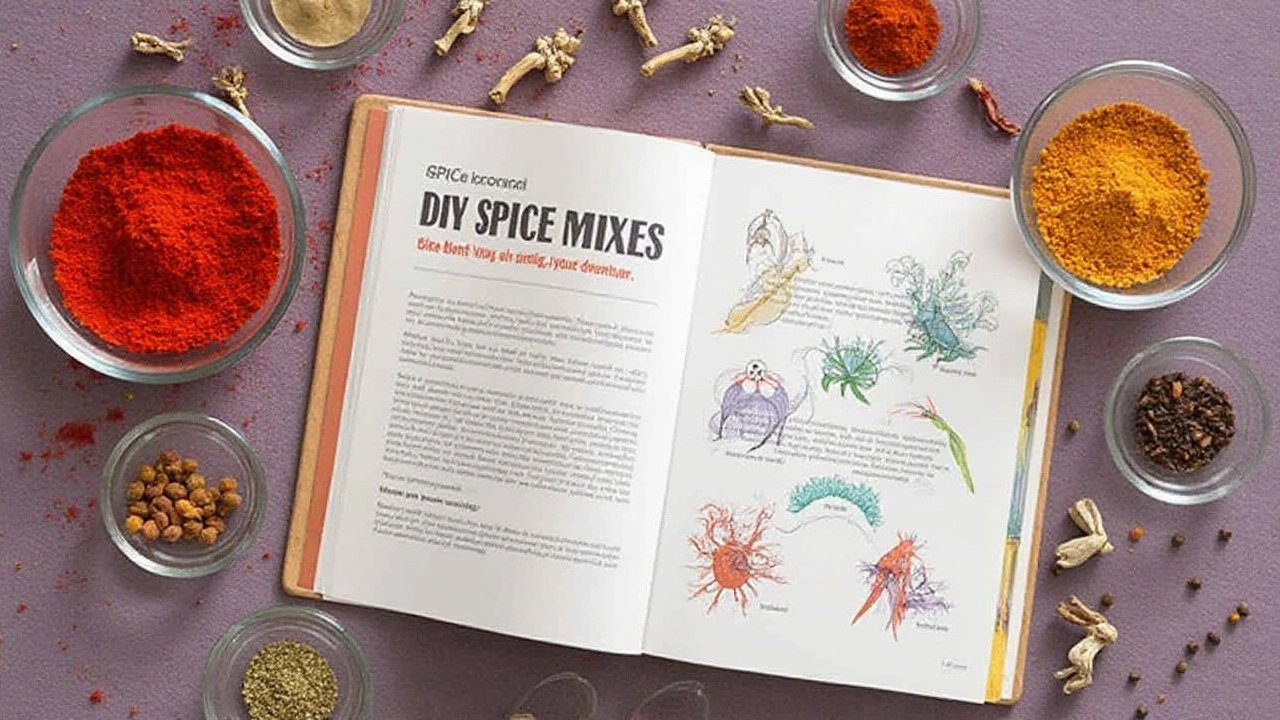24 Nov 2024
- 0 Comments
Tandoori chicken, with its vibrant flavors and charming aroma, is a favorite around the world. Yet, what happens when you run out of tandoori masala? Fear not, because culinary creativity knows no bounds. This article ventures into the realm of spice substitutes that can serve as excellent replacements for tandoori masala in your kitchen.
Understanding the key components of tandoori masala opens doors to various alternatives. Whether you seek a specific brand or prefer crafting your own mix, options abound for delivering that spicy kick. We'll navigate through common pantry ingredients that can help replicate the magic, ensuring your dish never falls flat even in the absence of the traditional blend.
- Understanding Tandoori Masala
- Common Substitutes for Tandoori Masala
- Homemade Spice Blends
- Cooking Tips with Substitutes
- Enhancing Flavor in Tandoori Chicken
Understanding Tandoori Masala
Tandoori masala stands as a cornerstone of Indian cuisine, offering a remarkable blend of spices that infuse dishes with flavor and color. Originating from the northern regions of India, this spice mix is essential for creating the deep red hue and smoky taste that define authentic tandoori chicken. Typically, tandoori masala includes a rich assortment of spices such as cumin, coriander, nutmeg, cinnamon, and cloves. Paprika or Kashmiri chili powder often adds a red tint, enhancing both the visual appeal and the piquancy of the dish.
This blend isn't just about heat; it also embodies a harmonious balance of sweetness, earthiness, and spice. Garam masala, another well-loved spice mix, frequently overlaps with tandoori masala in its components, yet the presence of unique ingredients like dried mango powder, a souring agent known as amchur, distinguishes tandoori masala. These nuances create layers of flavor complexity, making it a versatile component not just for grilling chicken but also for flavoring vegetarian dishes and even some seafood.
Creating authentic tandoori flavors without the store-bought masala involves true culinary artistry. According to Indian culinary expert Madhur Jaffrey, “the intricacies of spice blending can transform even the simplest ingredients into a gourmet experience.” A homemade tandoori masala can offer a fresher taste and the opportunity to tweak the proportions based on personal preference, allowing cooks to dial up the heat or increase the aromatic elements as desired.
Since traditional tandoors, clay ovens used for cooking tandoori chicken, reach incredibly high temperatures, the masala must withstand intense heat, which helps in infusing the chicken's skin with an irresistible char and vibrant color. Understanding these cooking techniques, along with the spice mix's composition, helps cooks craft sumptuous dishes at home, ensuring the meat remains juicy and bursting with flavor. Tandoori masala serves as more than just a seasoning; it is a testament to the rich cultural tapestry of Indian cuisine and an enduring reminder of India's culinary ingenuity.
Common Substitutes for Tandoori Masala
Creating that signature tandoori chicken flavor doesn't necessarily mean you need to have tandoori masala in your spice cabinet. There are several substitutes that not only mimic the vibrant taste but also introduce unique profiles to your dish. One readily accessible alternative is garam masala, which typically contains many of the same spices found in tandoori masala. By adding a touch of paprika or cayenne pepper to garam masala, you can achieve that distinct reddish hue alongside the quintessential spiciness. This substitution offers a simple solution for anyone without direct access to specialized spices.
Another excellent choice is the humble curry powder, a common pantry staple, especially in Western households. While not identical, curry powder can provide a baseline of flavor that can be augmented with additional spices such as garlic powder, ginger, and a hint of lemon juice to replicate the tandoori zest. Experimentation is key here, adjusting measurements to tailor the taste closer to the usual tandoori experience while adding your personal twist. "Adaptation is the secret ingredient to keeping cuisines alive," notes culinary expert, Madhur Jaffrey, emphasizing creativity in the kitchen.
For those who love a DIY approach, concocting your own blend at home can be rewarding. Start with equal parts cumin, coriander, and ground turmeric; these form the backbone of the mix. Adding some garam masala, chili powder, and smoked paprika will bring depth and color to your homemade masala. If you enjoy a smoky aroma, a touch of ground fenugreek works wonders in giving that slightly bitter yet delightful undertone. Crafting your own blend allows for a tailored flavor to suit any particular tandoori chicken recipe you have.
Smoky flavors can also be enhanced with smoked paprika or chipotle powder, both perfect for replicating the outdoor tandoor oven taste that's traditionally infused into the chicken. As a budget-friendly solution, consider using a mixture of these spices in varying amounts to control the heat and intensity of the dish. A well-balanced blend can not only save a trip to a specialty store but also provide a satisfying experience reminiscent of authentic recipes. Adding a dollop of plain yogurt mixed with these spices can further tenderize the meat while maintaining the cherished tandoori essence.

Homemade Spice Blends
Creating your own spice blend at home can be an enriching and rewarding experience, especially when it comes to replicating the magic of tandoori masala for your culinary endeavors. Homemade blends not only offer the authenticity of customized flavors but also allow you to take control of the spice level and texture. One of the remarkable aspects of making a spice blend is that you can incorporate fresh, high-quality ingredients directly from your kitchen, ensuring each component contributes to the final awe-inspiring flavor of your tandoori chicken. Start with cumin, coriander, and paprika as your base. These spices come alive with the addition of garlic and ginger powders, bringing a familiar warmth that is essential to tandoori dishes.
To amplify the authenticity, try adding a pinch of cayenne pepper for that subtle heat and a striking color. Smoked paprika can serve as an excellent choice, adding smokiness to the dish, reminiscent of traditional clay ovens. For an earthy undertone, turmeric is invaluable – it's almost like sprinkling sunshine straight into your mix. Assembling these spices doesn't require extraordinary skills but does benefit from patience and precision. Toasting whole seeds lightly before grinding them can make all the difference, releasing their oils and enhancing flavor depth. Some kitchen enthusiasts insist that this small extra step moves a dish from delightful to unforgettable.
Like crafting any piece of art, finding the perfect balance may require several trials. Ensure you label every version, noting proportions for future reference. Over time, you might find that tweaking certain ratios leads to an ideal concoction fitting your unique taste profile. Renowned chef Madhur Jaffrey once stated,
"Spices are an art form of their own, allowing you to transform a dish into a profound experience."Embrace these words and start experimenting within your spice artistry. Keep in mind that freshly prepared blends hold their peak potency for about three months, so store your creations in airtight containers away from light and moisture.
Suggested Recipe for a Homemade Tandoori Blend
- 3 tablespoons ground cumin
- 3 tablespoons ground coriander
- 1 tablespoon smoked paprika
- 1 tablespoon ground ginger
- 1 tablespoon garlic powder
- 2 teaspoons cayenne pepper
- 2 teaspoons ground turmeric
Mix all ingredients in a small bowl, then taste and adjust based on personal preference. This comprehensive guide gives you a versatile foundation to explore flavors that can transform any simple poultry dish into a captivating tandoori chicken feast. Investing time in these kitchen experiments may just turn into the delightful cornerstone of your home cooking repertoire.
Cooking Tips with Substitutes
When you're looking to recreate the magic of tandoori chicken without the classic masala, it may initially seem challenging. But with a thoughtful approach, you can conjure up flavors that are both tantalizing and true to spirit. The key is understanding the role each spice plays and how they interact in your dish. Instead of focusing strictly on replacing the masala one-to-one, think creatively about what spices bring warmth, heat, and a touch of tanginess to your palate. Start by examining your spice cabinet; spices like paprika, cumin, coriander, and cayenne pepper can be your allies, forming the backbone of your mix. Combine them with ground ginger and garlic powder to create a base that mimics the earthy and fiery nuances of tandoori masala.
Once your spice blend is ready, it's crucial to apply it in a way that maximizes flavor infusion. Marination is your best friend here, as it ensures spices penetrate deeply and contribute to a juicy, well-flavored chicken. Choose a dairy base like yogurt or sour cream, which not only tenderizes the meat but also balances the spices with creamy undertones. To give the chicken an authentic tangy kick, add a squeeze of lemon or a splash of vinegar to the marinade, helping the spices adhere effectively to the meat.
Roasting techniques are another important aspect when using a substitute for tandoori masala. If you've got a grill or a convection oven, using high heat can bring that sought-after smokiness while ensuring the chicken remains succulent inside. But without these tools, a fiercely hot oven can work wonders as well. Consider using a broiler setting towards the end for the quintessential charring effect, reminiscent of clay oven cooking.
As the chicken cooks, pay attention to moisture levels. Too dry? Don't hesitate to baste with ghee or butter occasionally. This not only keeps the chicken moist but adds a layer of richness to the substitute spices. Finally, don't shy away from adding herbs such as cilantro or mint upon serving. These fresh components round out the plate and make for a great finishing flourish.
Remember this culinary journey is about experimenting and tuning the spices to suit your taste while capturing the essence of tandoori in new and exciting ways. As culinary expert Julia Child once said,
"The only real stumbling block is fear of failure. In cooking you've got to have a 'What the hell?' attitude."With this mindset, even spice substitutes can lead to unexpected success.

Enhancing Flavor in Tandoori Chicken
Creating tandoori chicken with an unforgettable taste involves a delicate balance of spices, marination techniques, and cooking methods. The first step towards enhancing its flavor is to choose your spices wisely. While traditional tandoori masala is a combination of many spices such as cumin, coriander, and garlic powder, understanding how these flavors work individually can help you substitute effectively. A crucial aspect is to toast the spices before using them, which can enhance their natural oils and intensify their aroma.
Another vital factor in flavor enhancement is the marination process. Ideally, the chicken should marinate for several hours or even overnight to allow the spices to penetrate deeply. Yogurt often forms the base of the marinade, providing a tangy backbone and tenderizing the meat. For instance, a blend of plain yogurt, lemon juice, ginger, and garlic paste with a mix of your chosen spices will coat each piece with a savory goodness that defines this dish. As culinary expert Madhur Jaffrey once said,
"The essence of Indian cooking involves coaxing the most intense flavors from fresh ingredients."
Beyond spices and marinades, the cooking technique can also significantly impact the flavor. Traditionally cooked in a tandoor, a clay oven, this dish benefits from high, direct heat, which seals in juices and chars the exterior perfectly. If you don't have a tandoor, replicating this at home can be done using a very hot oven or a grill to achieve similar results. A tip is to preheat the cooking surface and lightly oil the grates to avoid sticking, thereby ensuring even cooking and caramelization.
Exploring additional aromatic elements can bring an extra layer of depth to your dish. Ingredients such as cinnamon sticks, cloves, or cardamom pods can be added to the marinade or roasting pan to infuse subtle, yet complex flavors. For a smoky undertone akin to a traditional tandoor, consider using a coal smoking technique. Heat a small piece of charcoal until red hot, place it in a foil cup, drop it in the center of your marinated chicken, add a few drops of ghee, then cover the dish promptly to trap the smoke. This simple technique mimics the charred essence beautifully.
Finally, presentation plays a role in flavor enhancement too. Sprinkle fresh coriander leaves or mint over the cooked chicken before serving to introduce a fresh, vibrant note. Accompanying side dishes like naan bread or fluffy basmati rice can help balance the bold flavors of the chicken. When plating, consider a squeeze of lime, which provides a citrusy contrast that highlights the robust spices used.
